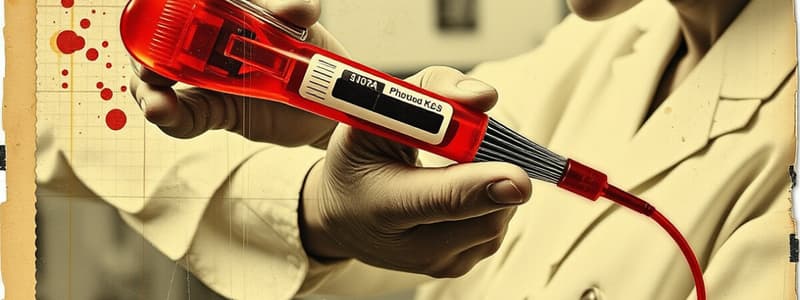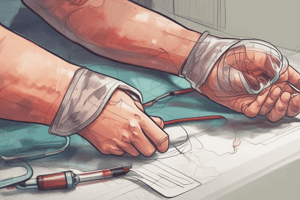Podcast
Questions and Answers
What should be done if alcohol is not allowed to dry before venipuncture?
What should be done if alcohol is not allowed to dry before venipuncture?
- It may cause specimen hemolysis. (correct)
- It improves patient comfort.
- It ensures proper needle insertion.
- It causes specimen contamination.
A needle with visible burrs or discoloration should be used for venipuncture.
A needle with visible burrs or discoloration should be used for venipuncture.
False (B)
What is the angle of needle entry recommended for venipuncture?
What is the angle of needle entry recommended for venipuncture?
15 to 30 degrees
After drawing blood, apply direct __________ to the puncture site.
After drawing blood, apply direct __________ to the puncture site.
When multiple specimens are required, what should you do after the first collection tube is filled?
When multiple specimens are required, what should you do after the first collection tube is filled?
Match the tube color with its primary use:
Match the tube color with its primary use:
It is safe to recap, cut, or bend used needles before disposal.
It is safe to recap, cut, or bend used needles before disposal.
What should you do with the used needle and holder after venipuncture?
What should you do with the used needle and holder after venipuncture?
What is the purpose of the tiny rubber sleeve in blood specimen collection?
What is the purpose of the tiny rubber sleeve in blood specimen collection?
It is acceptable to repeatedly have the patient pump their fist to make the vein more prominent.
It is acceptable to repeatedly have the patient pump their fist to make the vein more prominent.
What should be done after securing the tourniquet and selecting the best vein for puncture?
What should be done after securing the tourniquet and selecting the best vein for puncture?
The ______ sleeve automatically closes to prevent leakage during blood specimen collection.
The ______ sleeve automatically closes to prevent leakage during blood specimen collection.
Match the following tube types with their additives:
Match the following tube types with their additives:
How long should a tourniquet be left on the arm?
How long should a tourniquet be left on the arm?
It is recommended to leave the tourniquet on while the blood is drawn.
It is recommended to leave the tourniquet on while the blood is drawn.
What is the recommended action before removing the needle shield on a blood specimen needle?
What is the recommended action before removing the needle shield on a blood specimen needle?
What color is hemolyzed serum or plasma typically?
What color is hemolyzed serum or plasma typically?
Using a 21- to 22-gauge needle is recommended for routine blood collections.
Using a 21- to 22-gauge needle is recommended for routine blood collections.
What should be done if there is air leakage around the needle during blood collection?
What should be done if there is air leakage around the needle during blood collection?
Too much __________ in drawing blood may damage red cells.
Too much __________ in drawing blood may damage red cells.
Which of the following is a recommended practice for preventing hemolysis when performing venipuncture?
Which of the following is a recommended practice for preventing hemolysis when performing venipuncture?
Match the following steps to their purpose in preventing hemolysis:
Match the following steps to their purpose in preventing hemolysis:
How long should a specimen be allowed to clot before centrifugation?
How long should a specimen be allowed to clot before centrifugation?
Using a blood pressure cuff instead of a tourniquet increases the risk of red blood cell damage.
Using a blood pressure cuff instead of a tourniquet increases the risk of red blood cell damage.
Study Notes
Venipuncture Preparation and Technique
- Iodine can contaminate specimens; avoid using it for certain tests.
- Allow the puncture site to air dry after cleaning; drying with gauze is acceptable.
- If alcohol doesn’t dry, it may lead to hemolysis, which can affect test results.
- Perform visual inspection of the needle for burrs or discoloration before use; do not use damaged needles.
- Anchor the vein and insert the needle at a 15 to 30-degree angle.
Blood Collection Process
- For single tube collection, release the tourniquet when the tube is filled, and remove it carefully.
- In multiple sample collections, invert the first tube after filling to prevent clotting before inserting the next tube.
- A tiny rubber sleeve prevents leakage when changing tubes; do not recap or reuse needles.
- Use direct pressure on the puncture site after blood draw to minimize bleeding; prolonged bleeding over five minutes should be reported.
Safety and Disposal
- Lock the safety shield on the needle after use and dispose of in a sharps container.
- Follow exposure control plans for disposal; do not bend or cut needles.
Needle and Syringe Preparation
- Prepare the needle holder and attach the safety needle securely.
- Use caution while removing the needle shield and push collection tubes forward until the needle touches the stopper to maintain vacuum integrity.
Patient Positioning and Tourniquet Use
- Avoid having the patient pump their fist, which can alter results by shifting fluid concentrations.
- Do not leave a tourniquet on for more than one minute to prevent discomfort and hemolysis.
Puncture Site Preparation
- Clean the puncture site using a sterile alcohol sponge in a circular motion from inside to outside.
- Do not use iodine unless specified; hemolysis can occur if not handled correctly.
Hemolysis Prevention
- Use a 21- to 22-gauge needle for routine collections; a 23-gauge may be needed for elderly or pediatric patients.
- Replace vacuum tubes if there is air leakage or loss of vacuum to prevent specimen integrity loss.
- For difficult venipunctures, adopt gentle techniques to minimize red blood cell damage.
Collection and Processing Guidelines
- Avoid removing the needle while the tube is engaged; premature removal can cause hemolysis.
- Draw blood evenly and gently to minimize damage to red blood cells.
- Ensure the collection site completely dries after alcohol cleaning to prevent contamination.
- Do not collect specimens through a hematoma and allow samples to clot for 30 to 60 minutes before centrifuging.
Studying That Suits You
Use AI to generate personalized quizzes and flashcards to suit your learning preferences.
Related Documents
Description
This quiz covers essential phlebotomy techniques, emphasizing the importance of dry puncture sites and the handling of iodine contamination. Understanding how to properly prepare a patient for venipuncture is crucial for avoiding complications such as specimen hemolysis.




